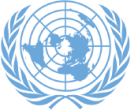About the Country
Brief Background
The Gambia gained its independence from the UK in 1965; it formed a short-lived federation of Senegambia with Senegal between 1982 and 1989. In 1991 the two nations signed a friendship and cooperation treaty. A military coup in 1994 overthrew the president and banned political activity, but a 1996 constitution and presidential elections, followed by parliamentary balloting in 1997, completed a nominal return to civilian rule. The country undertook another round of presidential and legislative elections in late 2001 and early 2002.
Flag
The flag is horizontally divided with stripes top to bottom RED, WHITE, BLUE, WHITE, GREEN. The RED color symbolizes the sun; The BLUE color symbolizes the River Gambia; The GREEN color symbolizes the land; The WHITE color symbolizes unity and peace.
Coat of Arms
The Coat of Arms depict two lions holding hoes supporting a shield that depicts a hoe and axe crossed with one another. On top of the shield is the heraldic helmet of a knight, and a oil palm above it. At the bottom is the national motto. The two lions represent the past history of Gambia being a colony of the United Kingdom. The axe and hoe that are crossed on the shield represent the importance of agriculture to the nation. They are also taken to represent the two major ethnic groups of Gambia: the Mandinka and Fulani. The oil palm tree found above the heraldic crest is an important local tree.
Capital
Banjul
National Day
18 February
Time Zone
Greenwich Mean Time (GMT)
Geographic Information
Map
Location
Western Africa, bordering the North Atlantic Ocean and Senegal
Coordinates
13 28 N, 16 34 W
Area
total: 11,300 sq km land: 10,000 sq km water: 1,300 sq km
Climate
tropical; hot, rainy season (June to November); cooler, dry season (November to May)
People and Culture
Population
1,546,848 (July 2004 est.)
Ethnic Groups
African 99% (Mandinka 42%, Fula 18%, Wolof 16%, Jola 10%, Serahuli 9%, other 4%), non-African 1%
Languages
English (official), Mandinka, Wollof, Fula, Jola, Sarahule, Serere, Manjango, Creole
Religions
Muslim 90%, Christian 9%, indigenous beliefs 1%
Government
Country Name
conventional long form: Republic of The Gambia conventional short form: The Gambia
Political Structure
A sovereign republic with a multi-party system of Government headed by a President who is elected by universal adult suffrage every five years. The President and his Secretaries of State (the Cabinet) form the Executive. A 42-member National Assembly (also elected every five years) constitute the Legislature while a set of independent judges, magistrates and barristers form the Judiciary. The Gambia is a member of several international organisations including the Economic Community of West African States (ECOWAS), the African Union (AU), the United Nations, the Commonwealth of Nations, and the Organisation of the Islamic Conference.
Administrative Divisions
Banjul, Kombo Saint Mary, Western Division, Lower River Division, North Bank Division, Central River Division and Upper River Division
Economy
Overview
The Gambia is primarily an agricultural nation growing groundnuts, rice, maize, millet and other cereals, and horticulture. Agriculture and fisheries combined account for nearly 60 per cent of Gross Domestic Product. Tourism is also a very important sector of the economy. It has become the biggest foreign exchange earner for the country and provides more than 16% of GDP. The industry provides employment for more than 10,000 Gambians. A small manufacturing industry is also developing with plastic goods and confectioneries as the main products. Gambian businessmen are also exploiting the country's low tariff regime and its vantage geographical position to develop a transit (re-export) market in neighbouring West Africa countries.
Exports
Groundnuts and groundnut products, Fish, Horticultural products, Hides and skins.


